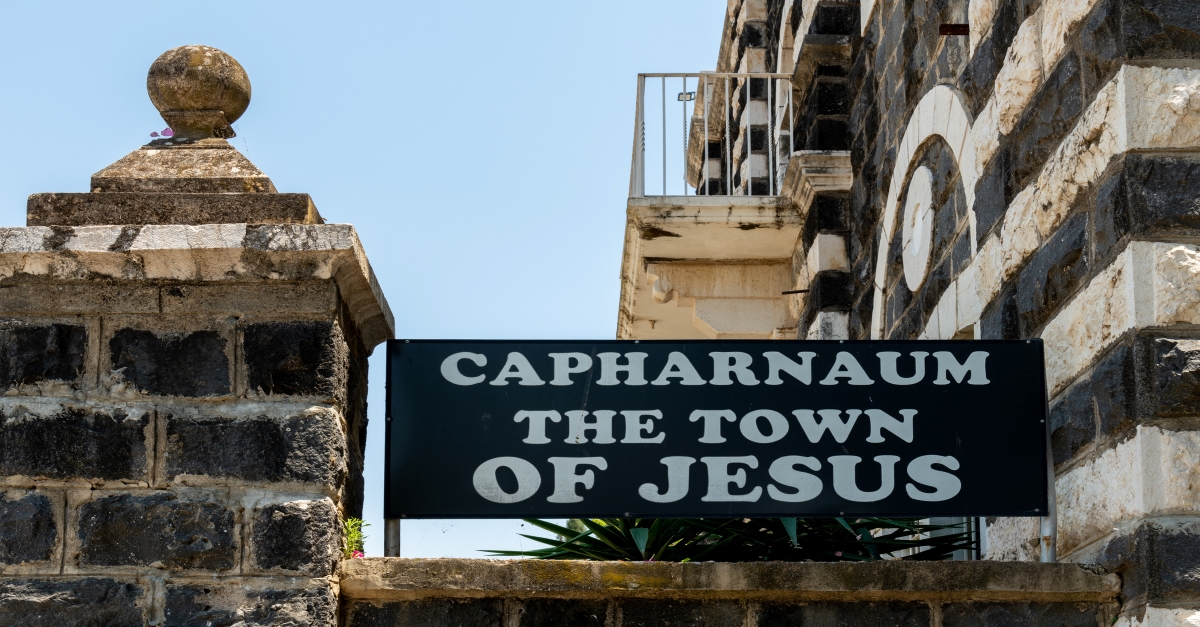Throughout his ministry, Jesus taught and performed many miracles in Capernaum. The Bible records these events throughout the four gospels. The people in Capernaum witnessed more of Jesus’s miracles than anywhere else. Jesus chose this location because of its popularity and the ability to spread his message throughout the region. Let’s dig deeper into the miracles Jesus performed in Capernaum and what happened to the ancient city.
Where Was Capernaum?
The city of Capernaum was located near the Sea of Galilee. Smith’s Bible Dictionary explains that the Sea of Galilee “is 60 miles northeast of Jerusalem and 27 east of the Mediterranean.” Capernaum sat on the western shore of the sea with Chorazin to its north and Gennesaret to its south. Jesus and his disciples resided in the city. The dictionary states that two different sites claim to be the location. One is called Kahn Minyeh. This pile of ruins is on the northwestern side of the seashore. The other attributed site is three miles north of Kahn Minyeh and is called Tell Hum; this is the most widely accepted location. Tell Hum is ”ruins of walls and foundations covering a space of half a mile long by a quarter wide, on a point of the shore projecting into the lake and backed by a very gently-rising ground.”
Because of Capernaum’s proximity to the sea, it was a popular trading village. The city stood near the Via Maris, a popular trade route connecting Damascus to Egypt. David Padfield notes, “Merchants and traders throughout the world could be found there—the traffic of the world passed through Capernaum.” This provided Jesus with an excellent opportunity to preach his message. The people passing through could hear his teachings and share them with others along their journeys. It’s no wonder his fame was able to spread far beyond the city limits of Capernaum.
Where Does the Bible Mention Capernaum?
Since Capernaum was a central part of Jesus’s ministry, the Bible mentions it many times. Jesus’ miracles are recorded throughout the four gospels. In Matthew 8:5, after Jesus returned to Capernaum from teaching outside the city, a centurion approached Jesus on behalf of his paralyzed servant. The centurion believed Jesus could heal the man in an instant. Jesus was amazed by his faith and “said to the centurion, “Go! Let it be done just as you believed it would” (Matthew 8:13). The centurion’s servant was healed at that moment. Later in verse 15, Jesus healed Peter’s mother-in-law, who was sick with a fever. Then, he freed those who were demon-possessed and cured others plagued by diseases.
Another miracle of Jesus calling out an unclean spirit from a man is documented in Mark 1:21-27. After Jesus commanded the spirit to leave, Mark 1:26 says, “The impure spirit shook the man violently and came out of him with a shriek.” A chapter later in Mark 2, Jesus healed a paralyzed man. His friends brought him to Jesus’s home in Capernaum, but it was so crowded they decided to lower him into the house through the roof. Because of their faith, Jesus healed the man, who got up and walked out of the house on his own.
In the third gospel of Luke, other miracles of healing are recorded. In Luke 8:41, a man named Jarius approached Jesus and told him about his ill daughter. He begged Jesus to come to heal her. On his way to their home, Jesus came across a very sick woman who had been bleeding for twelve years. The woman touched Jesus’s cloak, believing she could be healed. Because of her faith, she was cured. During this incident, a man from Jarius’ home came to tell him his daughter was dead, and Jesus didn’t need to come anymore. Jesus insisted the girl would still be healed and went to their home. Luke 8:54-55 reads, “But he took her by the hand and said, ‘My child, get up!’ Her spirit returned, and at once she stood up.”
More miracles from Capernaum are recorded in the last gospel of John. In John 4:43-54, Jesus was in Galilee. A royal official approached and told Jesus his son lay gravely ill in Capernaum. He urged Jesus to come to heal this son. Jesus assured the official his son would live. While the man was returning to Capernaum, he received word of his son’s recovery. His servant told him the boy’s health improved at one o’clock in the afternoon. John 4:53 tells us, “Then the father realized that this was the exact time at which Jesus had said to him, ‘Your son will live.’ So he and his whole household believed.”
Another miracle is recorded two chapters later in John 6:16-21. Jesus had just performed the miracle of feeding the five thousand. Afterward, he retreated to a mountain, and the disciples headed to Capernaum by boat. Soon into the disciples’ journey, the wind picked up. About three or four miles into their trip, they noticed a man approaching the boat and were afraid. Jesus told the disciples who he was, and they invited him into the boat. Immediately after, they reached the shore.
The next day, the crowd on the other side of the lake realized Jesus and his disciples had left. They stepped in boats and headed for Capernaum to search for Jesus. When the people found him, Jesus used the miraculous events from the previous day to teach them. He explained that earthly bread comes and goes like the one served the previous day. It only satisfies for a short time. However, the life he offers is eternal. John 6:35 states, “Then Jesus declared, “I am the bread of life. Whoever comes to me will never go hungry, and whoever believes in me will never be thirsty.” Jesus explained that those who believe in him would have eternal life. In John 6:51, he says, “I am the living bread that came down from heaven. Whoever eats this bread will live forever. This bread is my flesh, which I will give for the life of the world.”
Furthermore, the Bible mentions additional instances of Jesus teaching in Capernaum. One example is recorded in Mark 9:30-37. Jesus asked the disciples what they were arguing about; however, they were hesitant to reply since they had been arguing over who was the greatest. In Mark 9:35, Jesus says, “Anyone who wants to be first must be the very last, and the servant of all.”
Did Jesus Live in Capernaum?
Matthew 4:12-13 says, “When Jesus heard that John had been put in prison, he withdrew to Galilee. Leaving Nazareth, he went and lived in Capernaum, which was by the lake in the area of Zebulun and Naphtali….” While Jesus resided in Capernaum, it is unclear if he had his own home. Some believe his father, Joseph, had a house there, and others think he may have lived in the home of Simon Peter.
Wherever Jesus may have resided in Capernaum, Matthew Henry calls the city “his headquarters.” When Jesus entered Capernaum in the second chapter of Mark, people flocked to his home. Mark 2:2 says, “They gathered in such large numbers that there was no room left, not even outside the door, and he preached the word to them.” Even though it was assumed Jesus would preach on the sabbath, the crowd didn’t wait to see him in the synagogue. Instead, they came to his house on a weekday, and Jesus, deeming it unnecessary to make them wait for his teaching, spoke to them on the steps of his own home.

Photo Credit: Getty Images/Barbara Gabay
What Happened to Capernaum?
In Matthew 11:23, Jesus warned Capernaum. He said, “And you, Capernaum, will you be lifted to the heavens? No, you will go down to Hades. For if the miracles that were performed in you had been performed in Sodom, it would have remained to this day.” As mentioned above, Jesus performed many miracles in Capernaum, but there were still people who did not believe in him.
Jesus compared the people of Capernaum to those in Sodom, one of the most sinful places mentioned in the Bible. The people of Capernaum had the added offense of rejecting Jesus when he resided and walked among them. If the same miracles had been performed in Sodom, the people would have repented, saving the city. But Capernaum continued to reject Jesus and therefore faced condemnation.
Hundreds of years later, Capernaum was hit by several earthquakes. An earthquake in the 4th century A.D. leveled much of the city, followed by another in the 7th century A.D. that caused vast destruction. Capernaum was abandoned in the 11th century A.D. after a third earthquake completely devastated the city. Italian archaeologists began excavating the site in the 1920s and recovered the remains in 1981.
When tourists enter modern-day Capernaum, they are greeted by a sign that reads “Capharnaum, the town of Jesus.” While Jesus grew up in Nazareth, he spent much of his three years of ministry in Capernaum. There he taught people in homes and synagogues, spreading the revolutionary ideas of his message. He healed the sick and cast out demons, demonstrating his mighty power. The Bible documents many of these events, giving insight into the miraculous days Jesus lived on earth and resided in this ancient city.
Cover Photo Credit: ©Getty Images/Seasunandsky

Jenna Brooke Carlson is an elementary dual language teacher in the Chicago suburbs. As a member of American Christian Fiction Writers and Word Weavers, she enjoys spending time with other writers and perfecting her craft. Her debut novel, Falling Flat, spreads the message that healing can occur, even after tragedy. Along with writing, she’s pursuing her dreams of creating a community of brave young women, who she can encourage to live out their dreams amid challenges and imperfection. Her days are busy, but she’s determined she can conquer anything with a fuzzy blanket and a hot cup of tea. To find out more about Jenna, visit her website at jennabrookecarlson.com.
This article is part of our Bible resource for understanding the significance and meaning of biblical phrases and ideas. Here are our most popular Bible articles to grow in your knowledge of God's Word:
Promises of God in the Bible
Is "This Too Shall Pass" in the Bible?
What Was the Ark of the Covenant?
Top 10 Bible Stories for Kids
“Iron Sharpens Iron” in Proverbs 27:17
"Fearfully and Wonderfully Made" in Psalm 139
“Be Still and Know That I am God” in Psalm 46:10
"No Weapon Formed Against Me Shall Prosper" - Isaiah 54:17




.jpg)